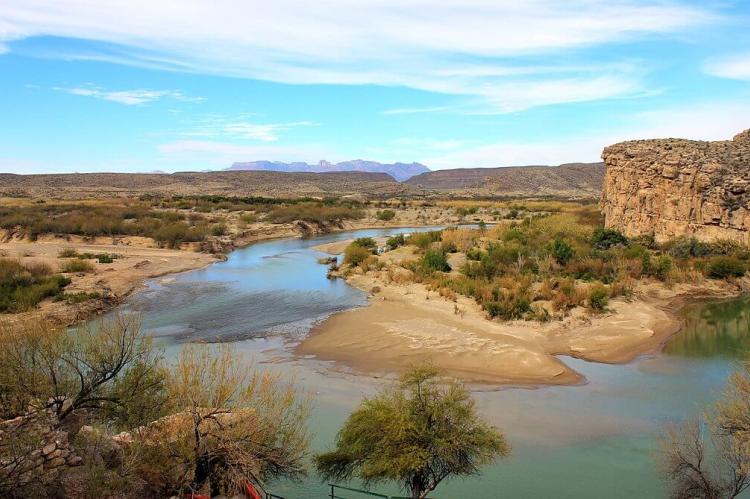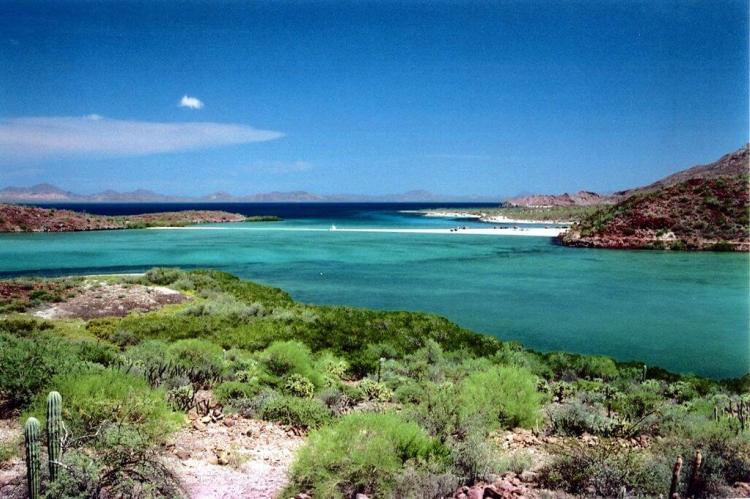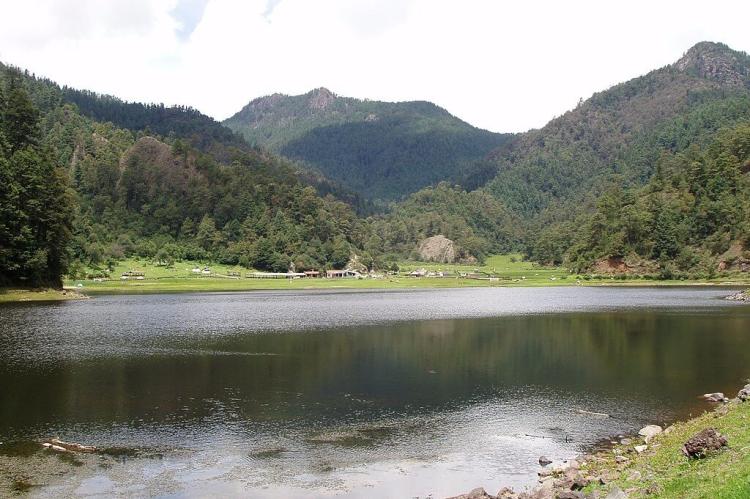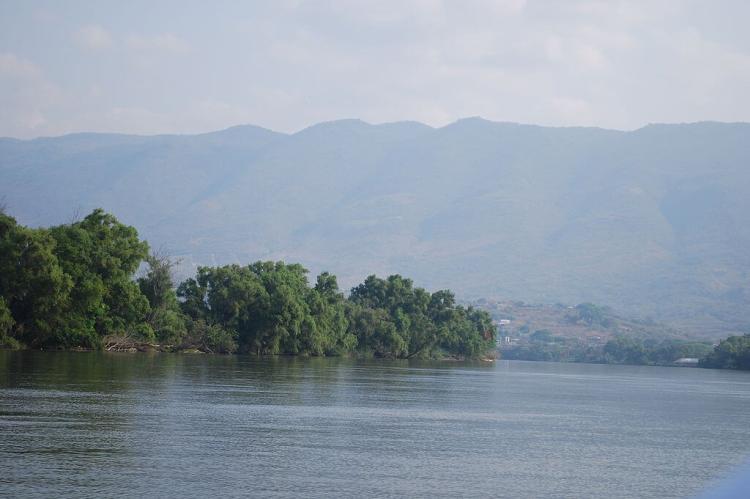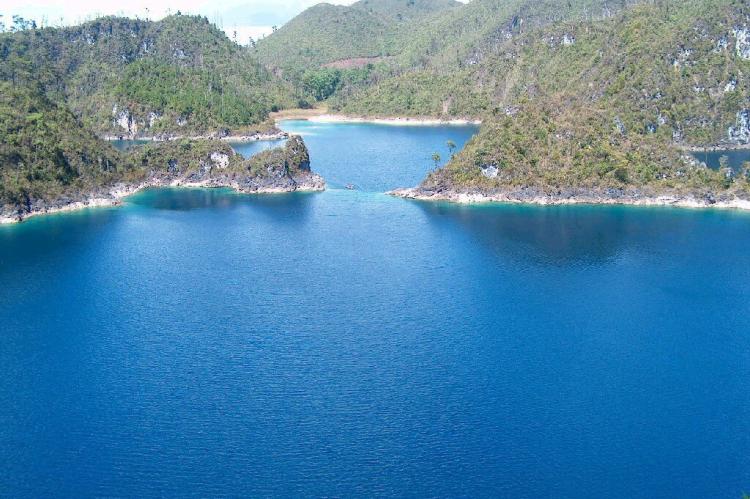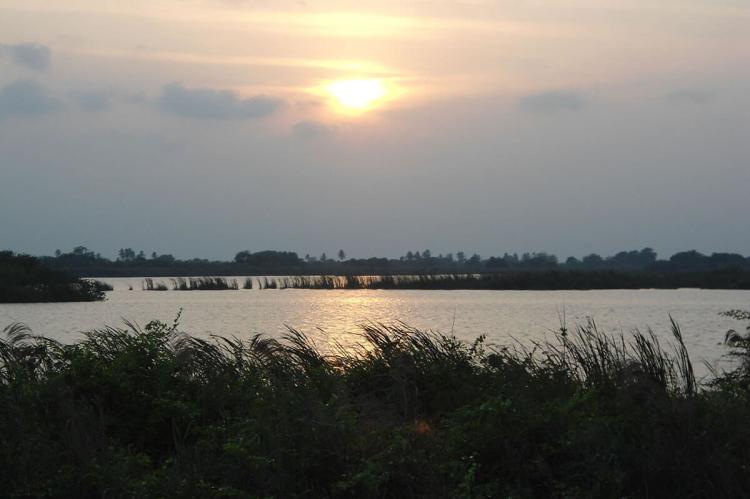Water Bodies of Mexico
Mexico is a country rich in bodies of water, encompassing various aquatic environments, from vast oceans and seas to lakes, rivers, lagoons, and wetlands. In addition to its coastal regions, Mexico features numerous inland water bodies that support agriculture and facilitate transportation and trade.
Water Bodies of Mexico
Mexico is a country that boasts a vast number of bodies of water, including oceans, seas, lakes, rivers, and lagoons that offer various aquatic environments. Apart from its coastal regions, Mexico is also home to numerous inland bodies of water.
The rivers in Mexico, such as Rio Grande, Usumacinta, and Lerma, play a vital role in supporting agriculture by providing water for irrigation and facilitating transportation and trade. Mexico's inland lakes and lagoons, including Lake Chapala, Lake Patzcuaro, and the coastal lagoons of Sian Ka'an and Celestun, are sanctuaries for biodiversity. These bodies of water provide essential habitats for different species of flora and fauna, contributing to the country's ecological diversity.
Overall, Mexico's bodies of water are crucial in sustaining ecosystems, supporting livelihoods, and offering recreational opportunities for both locals and visitors.
Gulfs, Bays, Coastal Lagoons, and Wetlands
Mexico's extensive coastline along the Pacific Ocean and the Gulf of Mexico is adorned with numerous gulfs, bays, coastal lagoons, and wetlands. These bodies of water are beautiful and scenic and play crucial roles in supporting biodiversity, providing habitats for marine life, and supporting various economic activities.
Gulfs
Gulf of California (Sea of Cortez): The Gulf of California, also known as the Sea of Cortez, is a UNESCO World Heritage Site between the Baja California Peninsula and the mainland of Mexico. It is one of the planet's most biologically diverse marine regions, home to various aquatic species, including whales, dolphins, and sea lions.
Gulf of Mexico: The Gulf of Mexico is a large body of water bordered by Mexico to the west and the southern United States to the north. It is renowned for its vibrant ecosystems, coral reefs, and vast marine life. The Gulf of Mexico is also a significant fishing, shipping, and tourism economic resource.
Bays
Banderas Bay: Banderas Bay is one of Mexico's largest and most picturesque bays on the Pacific coast near Puerto Vallarta. The Bay is famous for its 68 km (42 mi) stretch of scenic beaches, stunning sunsets, and clear waters, making it a popular destination for tourists and water sports enthusiasts.
Bahía de Acapulco: Acapulco Bay, situated along the Pacific coast in Guerrero, is an iconic and historic bay famous for its golden beaches and vibrant nightlife. Acapulco was once a glamorous destination for celebrities and jet-setters, and it continues to attract visitors worldwide.
Bahía de Campeche: The Bay of Campeche is a large bay along the Gulf of Mexico coast, forming the north side of the Isthmus of Tehuantepec. It lies between the Mexican states of Campeche, Tabasco, and Veracruz. The Bay's maximum depth is about 55 m (180 ft). It is known for its rich marine life and historical significance, with the city of Campeche, a UNESCO World Heritage Site, situated on its shores.
Bahía Concepción: Bahía Concepción is a stunning and picturesque bay located on the eastern coast of the Baja California Peninsula. It is situated in Baja California Sur, approximately 20 km (12 mi) south of Mulegé. It is renowned for its natural beauty and pristine beaches with crystal-clear turquoise waters. The Bay stretches over about 50 km (31 mi) and is surrounded by a diverse landscape of rugged desert hills and rocky cliffs, creating a breathtaking backdrop.
Coastal Lagoons and Wetlands
Laguna de Términos: Laguna de Términos is the largest tidal lagoon by volume, located entirely on the Gulf of Mexico and one of the most biodiverse. Exchanging water with several rivers and lagoons, the Laguna is part of Mexico's most crucial hydrographic river basin. It is essential commercially and ecologically by serving as a refuge for extensive flora and fauna; its mangroves provide a vital role as a refuge for migratory birds.
Laguna Ojo de Liebre (Scammon's Lagoon): Laguna Ojo de Liebre is a coastal lagoon in Baja California Sur along the Pacific coast. The lagoon is within the Vizcaíno Biosphere Reserve UNESCO World Heritage Site and is a Ramsar wetlands site. It is renowned for being a calving ground for gray whales during their annual migration, attracting whale-watching enthusiasts worldwide.
Laguna Madre: Laguna Madre is a coastal lagoon in northeastern Mexico that extends along the coast of Tamaulipas for over 200 km (125 mi). It's located in Matamoros, San Fernando, and Soto la Marina. The lagoon is separated from the Gulf of Mexico on the east by some barrier islands, including Barra Los Americanos, Barra Jesús María, and Barra Soto la Marina. It's bounded on the west by the Tamaulipan mainland.
Laguna de Tamiahua: Laguna de Tamiahua is a long coastal lagoon in the Mexican state of Veracruz. It's an inlet of the Gulf of Mexico and extends 104 km (65 mi) south of Tampico. The lagoon has brackish waters and is the third-largest coastal lagoon in Mexico. It contains the islands of Idolo and Juana Ramírez, and the settlements of Tamiahua and San Jerónimo lie along its shores. The peninsula of Cape Rojo separates the lagoon from the sea.
Laguna de Manialtepec: Laguna de Manialtepec is a coastal lagoon in Oaxaca. It is home to marine life, including turtles, dolphins, and fish. Laguna de Manialtepec is a popular birdwatching destination known for its bioluminescent plankton.
Pantanos de Centla Biosphere Reserve: Located in Tabasco, Pantanos de Centla is a vast wetland and one of the most extensive mangrove swamps in the world. It covers an area of about 3,000 square kilometers (1,160 square miles) and is a critical habitat for numerous species of birds, reptiles, and aquatic plants.
Ría Lagartos Biosphere Reserve: Ría Lagartos, situated on the northern coast of the Yucatán Peninsula, in the state of Yucatán, is a coastal wetland that is an essential habitat for flamingos, herons, and other migratory birds. The reserve encompasses both saltwater and freshwater ecosystems, providing a diverse range of habitats.
Marismas Nacionales Lagoon System: The Marismas Nacionales Lagoon System is an extensive, complex lagoon system that runs parallel to the coast for about 150 km (93 mi). The system is located on the western Mexican coastal plain, in the southern region of Sinaloa and the northern border of Nayarit, bounding the eastern shore of the Gulf of California. It is an interconnected complex of lagoons and wetlands on the alluvial plain formed by the Acaponeta, San Pedro Mezquital, and Grande de Santiago rivers.
Notable Lakes and Lagoons
Mexico is home to several notable lakes and inland lagoons, each offering unique landscapes, ecological significance, and opportunities for various recreational activities.
Lake Chapala: Lake Chapala, located in the states of Jalisco and Michoacán, is Mexico's largest natural lake. Picturesque towns and villages surround it, and it is a popular destination for tourists and retirees. The lake provides water resources for agriculture and supports various bird species, making it a significant ecological and economic resource for the region.
Lake Pátzcuaro: Lake Pátzcuaro, located in Michoacán, is famous for its cultural and historical importance. It is surrounded by several traditional indigenous communities and is known for the Day of the Dead celebrations in the area. The lake and its islands are home to unique biodiversity and provide a serene setting for visitors.
Lake Xochimilco: Located in Mexico City, Lake Xochimilco is an ancient artificial lake known for its chinampas and artificial agricultural islands. Xochimilco is a UNESCO World Heritage Site and a popular tourist attraction. Visitors can ride through the canals and experience the traditional floating gardens and colorful flat-bottomed wooden boats (trajineras).
Laguna de Tequesquitengo: Laguna de Tequesquitengo is a freshwater lake in Morelos. Originally a natural lake, Laguna de Tequesquitengo was dammed in the 1930s to create a reservoir for irrigation purposes. Over the years, it has become a prominent recreational and tourism spot popular for swimming, boating, and waterskiing.
Laguna de Zempoala: Laguna de Zempoala is a group of seven interconnected lakes in Morelos. The Lagunas de Zempoala National Park protects the lakes. The park is home to various wildlife, including birds, fish, and crocodiles. It is also a popular destination for fishing, birdwatching, and hiking.
Laguna Bacalar: Laguna Bacalar, known as the "Lake of Seven Colors," is a stunning lagoon in Quintana Roo, near the Caribbean coast. It is located near the border with Belize and is one of the largest lakes in Mexico. Its crystal-clear waters showcase different shades of blue, making it a beautiful and tranquil destination for relaxation and water activities.
Huasteca Potosina Region Lagoons: The Huasteca Potosina region in San Luis Potosí is home to several stunning lagoons, including Laguna de la Media Luna and Laguna de Tamul. These lagoons are set amidst lush tropical landscapes and offer opportunities for swimming, boating, and exploring nearby waterfalls and caves.
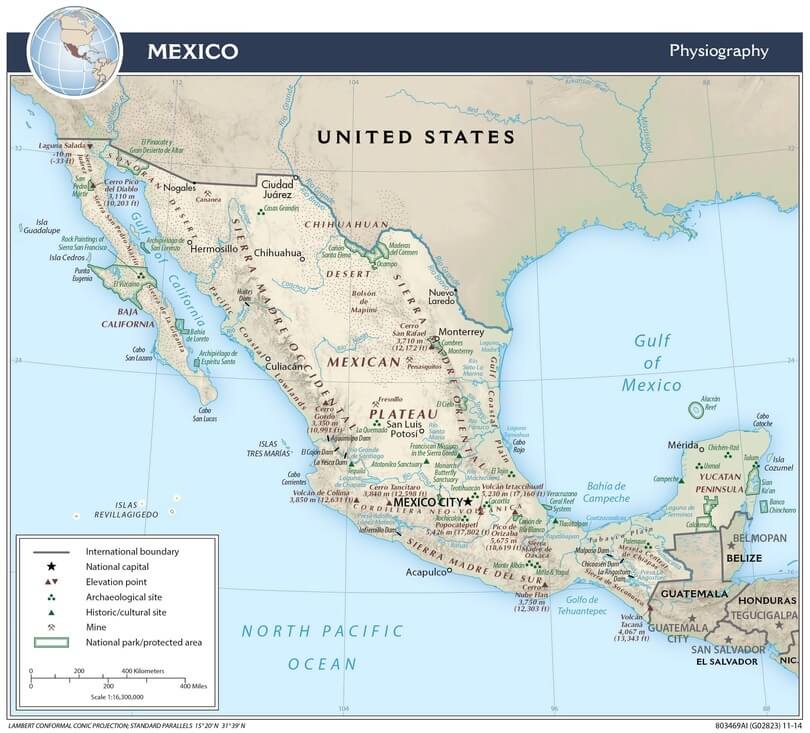
Mexico physiographic map.
Notable Dams and Reservoirs
Mexico has several notable dams and reservoirs that serve various purposes, including water storage, flood control, hydroelectric power generation, and irrigation.
La Angostura Dam and La Angostura Reservoir: Located in Sinaloa, La Angostura Dam is an important structure for water storage and flood control on the Culiacán River. The La Angostura Reservoir provides water resources for irrigation and supports agriculture in the region.
Infiernillo Dam and Infiernillo Reservoir: The Infiernillo Dam is situated on the Balsas River in Michoacán. It creates the Infiernillo Reservoir, which is the largest reservoir in Mexico. The dam's primary purpose is hydroelectric power generation, contributing significantly to Mexico's electricity production.
Miguel Alemán Dam and Miguel Alemán Reservoir: Miguel Alemán Dam, also known as the Falcón Dam, is located on the Rio Grande (Río Bravo del Norte) along the border between Mexico and the United States. The dam forms the Miguel Alemán Reservoir, providing water storage, flood control, and irrigation for agricultural lands in the region.
Chicoasén Dam and Chicoasén Reservoir: Chicoasén Dam is located on the Grijalva River in Chiapas. It creates the Chicoasén Reservoir, one of Mexico's largest artificial lakes. The dam plays a vital role in hydroelectric power generation, supplying electricity to various regions of Mexico.
Malpaso Dam and Malpaso Reservoir: The Malpaso Dam is situated on the Grijalva River, downstream from the Chicoasén Dam, also in Chiapas. The Malpaso Reservoir is another critical water storage and power generation facility contributing to Mexico's renewable energy supply.
El Cajón Dam and El Cajón Reservoir: El Cajón Dam is located on the Rio Grande de Santiago in Nayarit. The dam creates the El Cajón Reservoir, one of Mexico's largest reservoirs. It is a central hydroelectric power generation facility, producing a significant portion of the country's electricity.
Zimapán Dam and Zimapán Reservoir: The Zimapán Dam is situated on the Moctezuma River in Hidalgo. The Zimapán Reservoir is an important water storage facility and supports agricultural irrigation and aquaculture activities.
Notable Rivers
Mexico is crisscrossed by numerous rivers that flow through diverse landscapes, supporting ecosystems, agriculture, and human settlements. Here is a listing of some of the significant rivers of Mexico.
Rio Grande (Río Bravo del Norte): The Rio Grande, known as the Río Bravo del Norte in Mexico, forms a natural border between Mexico and the United States. It is one of the longest rivers in North America and plays a vital role in providing water for irrigation and supporting agriculture along its course.
Usumacinta River: The Usumacinta River is one of the most important rivers in Mexico and Central America. It originates in the highlands of Guatemala and flows approximately 1,000 km (620 mi) through the states of Chiapas and Tabasco in Mexico before serving as a natural border between Mexico and Guatemala and finally reaching the Gulf of Mexico. The Usumacinta River is known for its rich biodiversity and is an essential waterway for transportation and commerce in the region.
Grijalva River: The Grijalva River, also known as the Río de Tabasco, originates in the state of Chiapas, near the border with Guatemala, and flows approximately 480 km (300 mi) through the southern states of Chiapas and Tabasco before emptying into the Gulf of Mexico. It is one of Mexico's major rivers and plays a crucial role in hydroelectric power generation, with several dams along its course.
Lerma River: The Lerma River originates in the State of Mexico and flows through several states, including Guanajuato, Michoacán, and Jalisco, before reaching its endpoint in Lake Chapala, the largest natural lake in Mexico. Due to human activities and industrialization, it is one of the most polluted rivers in Mexico.
Balsas River: The Balsas River is one of Mexico's longest and most significant rivers. It originates in Puebla and flows through several states, including Guerrero, Michoacán, and Mexico, before reaching its endpoint in the Pacific Ocean. It provides water resources for agriculture and supports various ecosystems, including wetlands and forests.
Sonora River: The Sonora River is significant in the northwestern part of Mexico. It originates in Chihuahua and flows through the state of Sonora before reaching its endpoint in the Gulf of California (Sea of Cortez). The Sonora River is historically and ecologically important, as it has been an essential water source for the region's agricultural activities.
Papaloapan River: The Papaloapan River is one of Mexico's most important and longest rivers. It originates in the state of Oaxaca and flows through the states of Veracruz and Oaxaca before emptying into the Gulf of Mexico. The river and its surrounding region are known for their lush tropical landscapes, wetlands, and rich biodiversity.
Yaqui River: The Yaqui River is significant in the northwestern state of Sonora, Mexico. It originates in the Sierra Madre Occidental mountain range and flows approximately 320 km (200 mi) before reaching its endpoint in the Gulf of California (Sea of Cortez). The Yaqui River holds cultural and historical importance, as the indigenous Yaqui people have inhabited it for centuries.
Coatzacoalcos River: The Coatzacoalcos River flows approximately 240 km (150 mi) through Veracruz and Oaxaca and empties into the Gulf of Mexico. It is a vital waterway for transportation and commerce, and its estuary provides essential habitats for wildlife.
Fuerte River: The Fuerte River, known as Río Fuerte in Spanish, is a significant river in the northwestern part of Mexico. It originates in Chihuahua and flows through the states of Sinaloa and Sonora before reaching the Gulf of California (Sea of Cortez). The river is approximately 470 km (290 mi) long.
Lerma River: The Lerma River is one of the most important rivers in Mexico. It originates in the state of Mexico and flows through the states of Guanajuato, Michoacán, and Jalisco. The river stretches over approximately 750 km (466 mi) before reaching its endpoint in Lake Chapala, the largest natural lake in Mexico.
Pánuco River: The Pánuco River is one of the most important rivers in Mexico. It is located in the eastern part of the country and flows through San Luis Potosí, Hidalgo, Querétaro, and Veracruz. The river stretches over approximately 400 km (250 mi) before emptying into the Gulf of Mexico. The river is historically significant as it was a major waterway for transportation and trade during the colonial era.
Champoton River: The Champotón River is significant in Campeche, Mexico. It flows through the municipality of Champotón before emptying into the Gulf of Mexico. The river is renowned for its historical significance, as it was the site of the Battle of Champotón in 1517. This battle was one of the early conflicts between Spanish conquistadors, led by Hernán Cortés, and the indigenous Maya people.
Nazas River: The Nazas River is a significant river in northern Mexico. It originates in Durango and flows for 560 km (348 mi) through parts of Coahuila before eventually reaching its endpoint in the Nazas Lagoon, also known as Lago de Don Martín, in Durango. The river's water flow primarily depends on seasonal rainfall and snowmelt from the surrounding mountain ranges.
Rio Grande de Santiago: The Rio Grande de Santiago, often called the Santiago River, is a major river in western Mexico. It originates in the state of Jalisco, near Lake Chapala, and flows through the states of Nayarit and Jalisco before emptying into the Pacific Ocean. The Santiago River is one of the most essential waterways in the region, serving as a crucial water source for agriculture and supporting the irrigation of crops along its course.
